Basement Floor leaks, help please
My wife and I bought our home around 1.5 years ago and have had water issues coming from the walls and a crappy chop/patch job from the realtors contractor.
We have just foamed the walls a few weeks ago (pictured) and it has definitely done the trick. It even rained a couple times and nothing, but these past 3 days it has been raining on and off pretty good and now the cracks in the floor have seeped water/moister in. Some spots are just damp while a couple others are about half an inch of water or more.
I am not looking to finish the basement completely, yet. Though, I want to put the exercise equipment in the main area where it has been getting the most water and I will be turning a separate room down there into a studio for my drumming and music creating which will have a lot of expensive equipment at stake.
I see all of these things at the store and online that I could paint on that say it seals and locks moister out, but I guess I am making this out to be a lot worse in my head than it really is, but I'm hesitant to trust a coat of "paint" to keep years of investing safe. We all have our happy place(s) :)
I guess what I am asking is am I okay with just buying "over the counter" sealer-paint or is there something else I should do or even a combination of things?
Here is what I have going on so far…
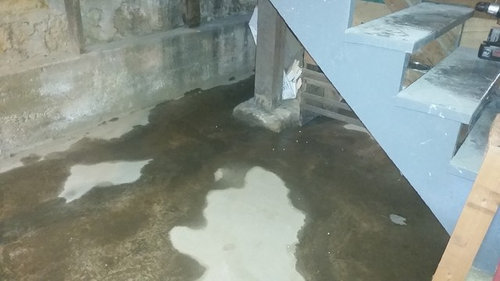
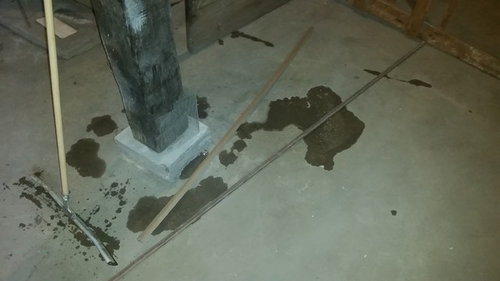
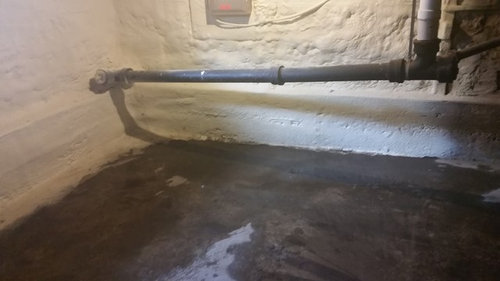



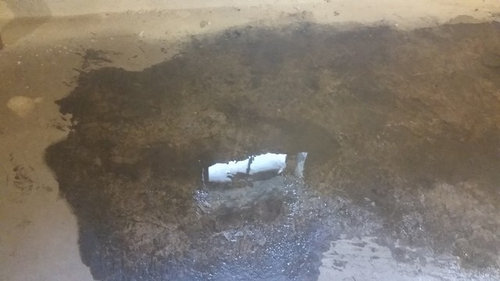
Thank you in advance! :)
Comentarios (70)
lhutch13
hace 8 añosI'm I iowa and you need to have your basement waterproofed. Spray foam is not the solution because water is still coming in and going to make the spray foam moldy, causing a whole other problem. Spend the money to call a waterproofing company and get your problem taken care of.Bevan Rice agradeció a lhutch13- Bevan Rice agradeció a loic_chevalier
kittnkaboodle
hace 8 añosWe had water all the time! Put in two sump pumps and have not had water since!Bevan Rice agradeció a kittnkaboodleloic_chevalier
hace 8 añosThe trick is to keep the water level below the ciment floor/fondations, sump pumps can to the job, that's for sure, but I didn't have space to put them.
Bevan Rice agradeció a loic_chevalierKathleen Marineau
hace 8 añosLooks like expensive work, $10,000, $30,000? Is that metal up against the basement wall?
We'd have to disconnect and move 2 propane tanks, (no stove for the duration), tear out the front
porch, the rhodedendroms and a cypress, assuming we could afford to have it done properly. We might even lose the sun porch which extends from the house to the detached garage.Bevan Rice agradeció a Kathleen MarineauKate Dingle
hace 8 añosYour basement looks very similar to mine. As others have mentioned, you need to put a French drain all around the inside perimeter of your basement and then use a plastic wall sheeting to direct the water to a sump pump. I have just done this and now my basement is dry and I can refinish it. This is expensive but then you will have no more concerns. This method of repair is less than half the cost of trying to fix the outside perimeter. Talk to a basement contractor. http://www.basementsystems.com/
Bevan Rice agradeció a Kate Dinglestlouisgaltoo
hace 8 añosI felt your pain for 12 years! Finally, we contracted a waterproofing company to fix the stinky, oozy farmhouse basement. Yes, french drain, replaced the sump pump well, etc. The BEST $$$ spent ...ever!! Pay a professional, IMHO. No more sitting water or stench. Do it! Find a reputable company and get it done! We have mot had any issues for over a year, even with this springs torrential rains. I am sorry we put it off!Bevan Rice agradeció a stlouisgaltoostlouisgaltoo
hace 8 añosKathleen, you need to get quotes. The price depends on the work quoted and the size of the basement. For us, it was worth the $$ spent and the wear and tear on my marriage. (He balked, I b-yotched.) PS: I had the nasty old basement windows replaced too! All 7! That added $2,700 to the project but so worth it too!Bevan Rice agradeció a stlouisgaltoo- Bevan Rice agradeció a stlouisgaltoo
appytrails
hace 8 añosWe had a basement just like yours. We hired someone to treat the inside walls, and all that did was move the wet spot to the center of the floor, instead of just seeping along the walls and perimeter of the floor.
Having two good friends use B-Dry to waterproof their terribly wet basement successfully, we called them and got an estimate. IT was not cheap, but they came out, figured out what was needed to fix the problem permanently (yes, it was a french drain installed on the inside perimeter of the basement, leaving my landscaping intact) and we have had a completely dry basement ever since... at least 10 years of heavy rains and two hurricanes later.
I would suggest not wasting money on fixes that don't fix the problem. We spent several thousand dollars each time over several years listening to people who promised to fix the problem and didn't before we bit the bullet and had it done correctly and permanently.Bevan Rice agradeció a appytrailsAakriti consultants
hace 8 añosIt is a structural problem water proofing will temporarily solve your problem but this is not a permanent cure you have to make your basement structurally safe.pl consult structural engineer.Bevan Rice agradeció a Aakriti consultantsKathleen Marineau
hace 8 añosstlouisgaltoo: We do not have natural gas lines in our neighborhood, so we have a pair of 100gal propane tanks. One for the gas fireplace and cookstove on the main level and another for the wall heater and cookstove in the basement. The previous owner converted the house to 2 rental apartments, so the basement has 2 bedrooms, family/living room, full bath and laundry and a full kitchen. We're using it as a single home, but are glad we had room for our daughter's family when their apartment in town burned. It was an 1830s building, probably an electrical fire.
The idea of internal french drains seems more destructive than resealing the exterior because it would mean gutting the entire downstairs apartment. Unless they could put a jog in the floor drain, it would also include removing two water heaters and the pressure tank for our well. The six of us, including a newborn, would have to move out while the work was being done, but still be come home every day to take care of the animals.
When you don't live in town it's a lot more work to redo what has worn out.
Here is a photo of the 8x20 unfinished portion of our walkout basement. A moisture meter read 90-100% on the floor at the foot of the stairs. We have a battery back-up for our sump pump and have needed it.

Here is the link to more photos:https://www.houzz.com/discussions/rain-fed-stream-under-basement-dsvw-vd~3007849
Bevan Rice: have you solved your basement water problem yet?Bevan Rice agradeció a Kathleen Marineauphoebe3
hace 8 añosÚltima modificación: hace 8 años@Kathleen - We bought an old farmhouse that had settled because water under the foundation had cracked the cement and the house had settled. When it rained, you could see a stream of water pouring through the foundation and running under the house. Everything was wet all of the time.
We hired a company to put in a French Drain along the exterior of the house. They dug the trench by hand an I only lost a couple of bushes that were too close to the foundation, anyway. In addition to collecting the underground water and routing it 20 feet behind the house on the downhill slope, they also directed all of the rain gutters into the french drain so no water collects near the foundation. Because they dug by hand, they could avoid existing pipes. They had to remove plantings that were within 2' of the foundation.
The previous owners told us there were times when the basement had 4" of water in it. Now, it is completely dry. I live in the San Franciso area where labor is very expensive so the cost was $9,000. Sounds like a lot, but cheaper than repairing foundation is going to be. It took 4 days.
Our friend's son put in his own french drain and it only cost him about $3,000 including renting a backhoe.
Bevan Rice agradeció a phoebe3mommamac75
hace 8 añosI have dealt with this same issue in my own home and we corrected it! our issue was that our water table is too high so we hired a contractor and had an interior french drain put in (almost 6 years ago). the drainage system goes around the entire perimeter of the basement and we have 1 sump pump. the project cost $8000 however it permanently fixed our wet basement. our neighbour's on both side of us had the same exact poblem (all 3 of our houses were built at the same time) and after our suggestion they did a french drain too, problem solved for them as well. I hope my input helps good luck!Bevan Rice agradeció a mommamac75jjcreech
hace 8 añosDid the seller disclose the water problem? If not you may have a claim against the seller to remediate the water leakage. This is not an easy or inexpensive fix.
Bevan Rice agradeció a jjcreech- Bevan Rice agradeció a gerby7
sarwangrewal
hace 8 añosFirst of all without all the facts here is personal opinion. If you do not have a drain tile surrounding your basement footings. Please have one installed and have it connect to a sump pump (I could not make one out in the photos). Since they (a professional contractor) will have to dig they entire perimeter up have them backfill with sand it will allow for proper drainage to the new drain tile, this will help keep the hydrostatic pressure of any ground water trying to force itself into your basement. If you have a drain tile, have looked at by a plumber. They can snake it with a camera to see if it obstructed or crushed in. If it's a new home a bad backfill job could be the result or and old home usually results in tree roots finding its way into the drains.Bevan Rice agradeció a sarwangrewalsuezbell
hace 8 añosÚltima modificación: hace 8 añosIf you are looking for a less pricy temporary solution, perhaps after the basement dries -- when it is completely dry -- consider coating the floor with waterproofing (I found some in white that is paintable). You might even consider "painting" the floor with roofing cement-- perhaps more than one layer -- it comes in thin clear and thick black (the white coating is usually for metal roofs). The concrete below will, of course still get wet but the wet may well stay under the roofing cement rather than putting moisture into your home.
Edit to add: See if the lay of the land/landscaping around your home directs water toward your home and, if so, consider addressing that along with your more permanent fixes.Bevan Rice agradeció a suezbellJudy Bath
hace 8 añosThis is bad. It looks like the water is coming up through the floor and not in around the perimeter. If the water were coming from the perimeter only then yes the French drain would do it but you have a lot of water and it appears to be everywhere.
first figure out where the water is coming from. Possible sources are the following:
1) downspouts that are plugged or misdirected
2) exterior water coming in from exterior drains that are plugged
- water coming up through the cement from a high water table in the area (boggy or marshy surrounding conditions) or an underground spring
When does this occur? Only when it rains? When the snow melts?
Also check that your neighbors do not have their downspouts, ground water or streams running onto your property.
Possible solutions are the following:
1) redirect downspouts away from the house into French wells in the yard
2) install a French drain around the perimeter of your house with perforated pipe to get the water away from the house to French wells
3)install a sump pump to that will turn on when the water gets high enough to flood your basement.
I live in Seattle and every house I have owned has had one or more of these water issues. Here we have a form 17 when you buy the house that is supposed to disclose the leaks into the basement. It is a toothless worthless instrument because the sellers are under no legal obligation to disclose problems because if they don't you have no legal recourse to recover damages.
Good luck and bring your check book! Get several estimates and beware of really high or low ones. My last house rehab I hired day labor to bust up the concrete in the driveway, dug a 3 by 3 foot hole and filled it with drain rock. Also dug up a foot wide trench on either side of the driveway and filled that with drain rock so all of the driveway water is captured outside the house and none of it comes in. Redirected the downspouts so they are not going into the interior drainage system and dug French wells in the yard with perforated pipe going away from the house to the wells. Then tore off the tile deck and replaced it with membrane decking to seal the water out. Sloped the deck away from the house with a gutter system to make sure all water from the deck goes well away from the house. None of this was disclosed on the form 17.Bevan Rice agradeció a Judy BathKathleen Marineau
hace 8 añosAs for disclosures, the basement flooding from the remnants of Hurricane Sandy were listed. Power was out 3 days, so the sump pump was idle. They replaced carpet and the bottom 2 ft of drywall, added a battery backup for the sump pump and the insurance company declared it fit for habitation as an apartment.
What they didn't do was drylock the masonry brick all the way up, nor remove enough drywall to get rid of all of the mold. Of course the home inspector we hired didn't find that because the apartment was finished and visibly dry. We bought in September when almost no one around here has water problems. If we'd waited 3 months, we might not have purchased this home.Bevan Rice agradeció a Kathleen Marineauarreese
hace 8 añosWe live in an area that has a high water table...... the basement always flooded & has a sump pump continually running during the rainy season. Last year we had a french drain put around the outside of the house..... what a difference! This past winter the pump didn't run once! The basement is dry, it was really worth the money to have it done.
Bevan Rice agradeció a arreeseDurango Developments Ltd.
hace 8 añosI agree, I do not think that this is a DIY project. The problem you have is that you need to stop the exterior water from pushing itself in. You are right, a sealant paint will not cut it. And although you are having some success with the foam, that will not last. Water exerts a lot of pressure to get in. I would rate this as a pretty big problem that needs to be addressed before you develop the basement, this problem will not go away by itself.
Bevan Rice agradeció a Durango Developments Ltd.Anne Pratt
hace 8 añosWhen I lived in Suffield, Connecticut, we had terrible basement flooding problems. We contacted a local contractor to install drain tile. He said that everyone in Suffield (more or less!) had this problem due to a high water table. He recommended simply grading first, and only going to another method (drain tile, French drain, etc.) if that failed.
It worked. Grading the soil away from the foundation, and extending the downspouts. Cleaning the gutters. Amazing, and cheap. No fancy waterproofing that costs a fortune and can't help if the water needs a place to go.Bevan Rice agradeció a Anne Prattdlc84
hace 8 añosÚltima modificación: hace 8 añosWhen we bought our house we'd get several inches of water in the basement every time it rained hard. We redirected what water we could without calling in backhoes and got a new sump pump, and installed new gutters which helped but didn't keep out all the water. We used Armor Guard epoxy on the stone walls & concrete floor and it has been dry ever since. (About 6 yrs so far, even with drought bad enough to crack the midwestern clay soil then torrential rains to fill the cracks) Oddly enough Armor Guard is made of soy products and is (thankfully) odorless. We ordered it over the internet and applied it ourselves. The kit includes cleaner and the two parts of the epoxy. You have to work quickly since it hardens in about 20 minutes. We mixed up a lot of small batches and went through a lot of (cheap) paint brushes, it was a pain to get it in all the crevices of the old rock walls, but it has worked. It came in a few colors and leaves a high gloss finish. We've gotten a lot of complements on the finish, even though it was just installed as waterproofing. We are finally about to install a floating vinyl "wood" plank floor over it.
Bevan Rice agradeció a dlc84Gloria Guard
hace 8 añosStay away from "we waterproof basements" since much of the problem lies in the yard immediately outside your home. Build up the landscaping leading up to the house so there is an obvious downhill path for rain and water, Also check your roof and downspouts. Hiring a gutter cleaner is half the price of a waterproofer.
Bevan Rice agradeció a Gloria Guarddqgould
hace 8 añosI had the same problem with my house that was built in 1956. I had interior tile installed--they broke out the floor around the perimeter of the basement and installed tile covered by rock. They also drilled into each block to drain the water out of the walls. This is covered by a sheet metal "baseboard". I have 2 sump pump/pits to drain the two parts of my basement. I had the same water bubbling up through the cracks in my floor. I found this was due to soil--clay. The water did not drain through it and created pressure under the floor. This was done over 10 years ago and the only problems I have is when the one sump pump doesn't run during wet times (power outages/pump failure). I would suggest you have a pump with a battery back up put in, but make sure it is checked regularly. The most amazing thing is the actual tiling took maybe 6 hours and none of the dirt and debris came through my upstairs--all out a basement window. It was a great company out of Des Moines that has been in business for 50 to 60 years and it is not the one who advertises all the time. Hope this helps.
Bevan Rice agradeció a dqgouldUser
hace 8 añosI read every comment on this thread. Here's the thing, you live in the Midwest. We've had crap tons of rain in the last few months. Everyone has basement issues if they don't have drain tile and a sump pump. I live in the St. Louis region and there has been flash flooding in places that have never flooded, in 1973 or 1993. It's terrible and people have died. And basements are leaking. Our home had similar problems and we had interior drain tile and a sump pump installed 20 years ago. We also added length to the gutter downspouts to keep the water away from the house (approximately 12' and buried them for aesthetics). The basement hasn't leaked since. We used a reputable company, and as I recalled it was about $2800. I'm sure it's twice that now. Good luck, but don't be cheap - you'll put your expensive stuff down there and it will be ruined.
Bevan Rice agradeció a Usersweetkeight
hace 8 añosin addition to the french drain option, a drainage system around the perimeter of the house can achieve the same results. Once trenched a pipe system is placed, connecting all four sides to eave drain collection points situated at each corner of the house. After placement, the entire trench is refilled with limestone/gravel, etc. (trench width is 12-24inches) All of the buried drainage pipes lead either to a main collection point for rain-water retention or removal from the property through sewer lines. This method uses the same eave trough/gutters that you already have. Any water arriving toward your house from other than the roof travels to the buried pipes within the gravel. The pipes are pierced/slotted on the top making it possible for water to enter even if it's coming from some other point of entry than the corner eave drain.
There is no need to dig out sand, etc from this method as the gravel is in place to stop silt collecting in the pipes. An earlier poster mentions how their pipe system needed to be routinely re-dug to be rid of the sand that had clogged up after a rain. This is not necesary if the proper pipes for drainage are used in addition to placing the pipes in stone/gravel.
Sealant as you inquired, shouldn't even be an option. There is no spray or paint that is going to solve this problem.
Get serious about correcting the drainage issues OUTSIDE. This is where the problem is, and it's where your solution should begin.Bevan Rice agradeció a sweetkeightstlouisgaltoo
hace 8 añosKathleen M. I understand what a propane tank is. We have one. I did not understand you having to move yours. Your finished basement apartment would be a nightmare to go the inside french drain... I feel fortunate that our situation was "simpler" since there is no way we would finish our 1920's basement ( low ceilings) i am so happy that the basement is functional as storage and having my laundry room down there. Dry and no more stench that I could smell upstairs when it rained, etc. After reading everyones situations, ours seemed minor except for our procrastination of getting it fixed properly. 12 years was a long time to be very unhappy with the situation.Bevan Rice agradeció a stlouisgaltooKathleen Marineau
hace 8 añossweetkeight: how deep does the trench need to be? At the base of the basement wall or just below the surface?
stlouisgaltoo: I apologize if my post was harsh. I've met a lot of people who've never lived outside of a city who had no concept of not having everything piped in. The big difference here is the tanks are next to the house instead of 100' away as required in our previous home area in California. I guess it's because of issues with winter freezing.
Bevan Rice agradeció a Kathleen Marineaudesigngirl178
hace 8 añosIf the contractor that the realtor hired, created or made the problem worse you could and should sue starting with the realtor. In our state, the owners need to reveal any problems like this to the buyer by law. Check out your laws and talk with a lawyer. It may not seem like a large problem but the mold and mildew problem can mean significant health problems to your family and should be addressed. Good luck.
Bevan Rice agradeció a designgirl178happyleg
hace 8 añosKnock,knock again, I asked earlier what is happening? You had this up in May & it can't wait!
Bevan Rice agradeció a happylegOptions In Granite
hace 8 añosWow you got alot of great advice!
Franch Drain with Mir drain, new Sump pumps, dehumidifier that discharges directly into sump pit. Then you can dry loc and epoxy paint your basement after all moisture is gone!
Bevan Rice agradeció a Options In Granitecparfc438
hace 8 añosIf perhaps the (or a) source of leaking is due to tree roots pressing into and cracking/ breaking French drain tiles (thick terra cotta pipes that carry storm water away), then the trees need to be addressed. For our 1924 house,we think mature trees that are as close as 8 feet and as far as 12 feet were the culprits. In May, we spent just shy of $10K to trench, waterproof, new French drainpipe - now PVC- around half our perimeter. For the first time in 27 years--NO basement leaks. We preferred exterior remedy that seals from outside, rather than using the sump pump method , which actually invites the water into the foundation. Am not sure why that is considered a good idea, but I have several neighbors that are happy with sump pump. Good luck !Bevan Rice agradeció a cparfc438Bevan Rice
Autor originalhace 8 añosI apologize for the waiting, but I got hurt at work and have not been able to respond. We have not been able to fix the problem but the next step will definitely be installing a sump pump.
How thick is the average basement floor concrete? My home was built in 1918, concrete floor and concrete up to about 2 feet high for the walls, then limestone for the rest of the way up. We do use a dehumidifier when it is wet down there. We also need to reevaluate the grading of the property. That might be our biggest problem.
Anne Pratt
hace 8 añosGlad you are better! I don't know the answer about basement floors, but do check out the grading outside. So much cheaper than all the indoor interventions!
Kathleen Marineau
hace 8 añosBevan Rice: Glad you've healed enough to get on your computer.
Since we have a similar problem, I can tell you that gutter drains were a big part of our water intrusion. The one furthest from our basement emptied onto a gravel path around the garage. I noticed the ground had sunk about 3" since we bought the house, less than 2 yrs ago. Our future son-in-law dug a channel about 20' long and laid drain pipe from the gutter, the type with no side holes. The gutter water for the 2 car garage with attached shop now drains at the corner of the vegetable garden, well away from the basement.
We still have some hydrostatic seepage into our basement, but no more puddles.
Still to be completed is french drains and regrading in the front shrubbery bed and next to the house in the back yard.
Robert
hace 8 añosA leak in your basement floor can come from
a crack in the floor or the seam where your concrete floor and foundation meet.
Before you can begin to repair the leak, you will need to locate the source of
that leak. It will be less challenging to find it if you basement is
unfinished. If you want to prevent water infiltration in your basement, it is
important to consult with a waterproofing professional first. They can advise
you on the best way to ensure that your basement remains dry for longer.1818 Federal (7bEC)
hace 7 añosBevan Rice, how did your basement drying turn out? It's been about 15 months.
I just had an INTERIOR drain installed; regional company. ...plus 1.5hp sump, and Clean Space - both basementsystems products. It cost more than my 2 HVAC systems, so the entire education process (water table, downspouts, etc. has been a lot of time and energy).
1818 Federal (7bEC)
hace 7 añosKathleen Marineau, were your drains INTERIOR? or on the outside? Any mitigation yet for the hydrostatic pressure ?
Kathleen Marineau
hace 7 años1818 Federal: Our drainage system was laid on the outside. Family duties, the arrival of a new grandchild, kept us from doing the larger uphill drain project in 2016, so it's on the virtual calendar for 2017. So far the sump pump and running a dehumidifier appear to be keeping moisture levels low enough that we don't have new mold. But the locals say we're in a drought, so that is helping. Still seems like a lot of rain to this California native.
1818 Federal (7bEC)
hace 7 añosKathleen Marineau , how are you hyperlinking the name? #FeelingSlowwwww :)
1818 Federal (7bEC)
hace 7 añosÚltima modificación: hace 7 añosOh nevermind , Kathleen Marineau , I just did it (I think). It was simpler on a PC; I was using my phone before. #educable :)
Kathleen Marineau
hace 7 añosYep, on a PC. I don't do much internet stuff on my phone. Even with having a "barely fits in my Wrangler pocket" size, my old eyes have trouble discerning images on a cell phone.
suezbell
hace 5 añosWhat kind of yard do yo have -- would you be able to create mowable ditches to direct water away from your foundation.
Kathleen Marineau
hace 5 añosthat is a good idea suezbell. It could help with rain water on one side of the house, where we plan to hire a ditch digger. We have a new area of water infiltration. We suspect one of the underground streams that dumped into our sump pump has changed course and is seeping up through the concrete pad in a different location.
The good news is that we can see it. The dry season for us is September, so we are going to paint the exposed basement floor with drylock. We're debating about pulling up carpet and flooring in the entire basement to seal all of it.
I've been reminded of another good news view - we'll never be without water. The sump pump basin is a steady source of fresh spring water.
happyleg
hace 2 añosWe went through that number of years ago it's either the pipe a cracked wall and if it's a cracked wall you have to fix it plus you need to go outside to dig a trench down to the end of the basement wall you have to use tar and then you put plastic over that and put the dirt back good luck and you also need to have long gutter hoses attached to the house
Kathleen Marineau
hace 2 añosIt's been 6 years of following this and similar conversations. During that time we discovered that one underground stream stopped flowing and a new one from a different direction started., so we still have 3. As David Stockstill suggested, we painted the wet wall with dryloc.
Finally this summer we paid a local handyman (nearly everyone has sump pumps around here) to replace the water holding tank so it's at the correct level and install a whole new sump pump system. No more overflow, no standing water in basement and it has a cover, so no wet yowling cat risk.
Just in time. Last month we got a lot of rain in 1 day and our neighbor's sump pump failed. He is now paying for extensive water damage repair and had to get rid of all the furniture that was in the basement.

Volver a cargar la página para no volver a ver este anuncio en concreto

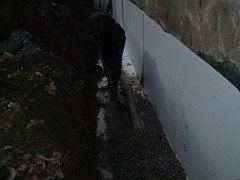
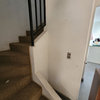

Kristin Snyder